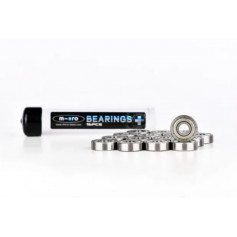Bearings for inline skates
Decoding Inline Skate Bearings: A Skater's Guide
The exhilaration of inline skating largely hinges on the seamless roll of your wheels, and that's where bearings play a pivotal role. If you're encountering issues with your skates not rolling as smoothly as they should, it's likely time to look at the bearings. Here’s a straightforward guide to help you understand and choose the right bearings for your inline skates.
Understanding Roller Skate Wheel Bearings
- Role and Quantity: Bearings are crucial for the smooth rolling of inline skates, located within the wheel hub. Typically, each wheel contains two bearings, meaning a pair of inline skates will have between 12 to 20 bearings, with the most common setup being 16 bearings for 8 wheels.
- Components: A bearing comprises five parts: the shield (protects against dirt), inner race (inner diameter), balls (facilitate movement), retainer (holds the balls in place), and outer race (connects to the wheel).
- Tolerance Standards: Initially, bearings were rated using the ABEC (Annular Bearing Engineer’s Committee) standard. Now, other standards like ISO (International Standard Organization) and DIN (Deutsches Institut für Normung) are also used. These standards differ regionally but aim to achieve similar quality goals. Additionally, brands like TWINCAM have their own standards, like ILQ.
Key Factors When Buying Inline Bearings
- Material: Bearings are typically made from steel or ceramics. While steel is common, look for high-quality types like Chrome, Swiss, or Titanium. Ceramic bearings, made from Silicon Nitride, offer superior strength and corrosion resistance.
- Tolerance Rating: Indicates the bearing's precision. Higher ABEC ratings imply better efficiency and speed. Conversely, lower numbers are preferable in ISO and DIN standards.
- Size: Modern bearings are generally 8mm, marked as 608, whereas older 7mm bearings are marked as 627. Our website features 8mm bearings, the standard size for contemporary inline and roller skates.
- Lubrication: Bearings use either grease or oil. Oil provides higher speed but requires more maintenance, while grease offers less speed but is more durable and resistant to dirt and water. Regular lubrication is essential to maintain performance.
- Shield: Bearings come with metal or Nylon shields. Metal-shielded bearings are often sealed, making them harder to clean and lubricate. Nylon shields are removable and easier to maintain, enhancing bearing efficiency.
Where to Find Quality Inline Wheel Bearings
If you’re in the market for high-quality inline wheel bearings, our online store is a great place to start. We offer a selection of budget-friendly, durable bearings suitable for various skating styles. With global shipping, finding the right bearings for your skates is just a few clicks away. Check all parts for inline skates that we sell.
